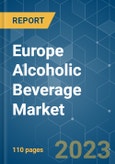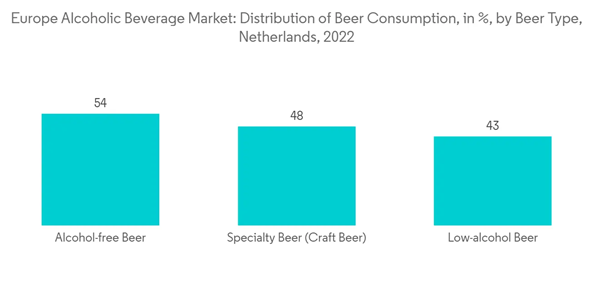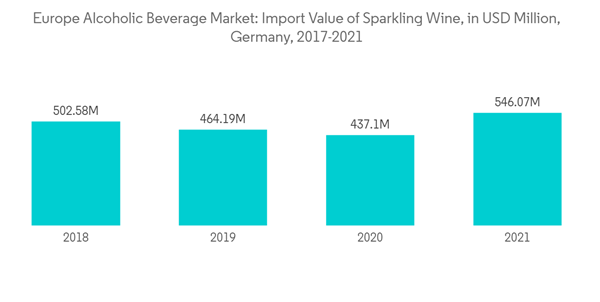Key Highlights
- Consumers across the region have been developing more sophisticated palates than before. They are constantly in search of unique as well as a high-quality alcoholic beverage. This has increased the demand for premium-quality alcoholic beverages in the market. Product innovation and economic growth make consumers opt for expensive alcoholic beverages. New product launches and innovations in alcoholic drinks are leading to the development of the industry.
- Companies are launching innovative products due to changing consumer preferences. This rise in health awareness has resulted in the creation of functional premium alcoholic beverages. The inclusion of different natural and exotic ingredients in alcohol tends to improve its functional properties, thereby gaining attention from a more extensive set of customers.
- For instance, in March 2022, Whitley Neill, a premium gin brand in the United Kingdom, launched a new gin variant, Oriental Spiced Gin. This gin consists of different botanicals and spices like coriander, ginger, chili, cumin, saffron, star anise, and grains of paradise.
- Furthermore, specialty beer has been gaining popularity among consumers in the Europe alcoholic beverage market, specifically younger consumers. The demand for light and fruity flavors in alcoholic beverages is driving the demand for craft beer, thereby escalating the demand for alcoholic beverages in the market.
- However, the prominence of health adversities associated with excessive alcoholic beverage consumption is prominent across Europe. The number of deaths related to alcohol consumption is rising, restraining the growth of the market studied.
- According to World Health Organization (WHO), as of 2022, the number of death caused by harmful use of alcohol catered to 3 million worldwide, representing around 5.3% of the total deaths across the globe. Therefore, the numerous health effects associated with alcohol might restrain the market's growth.
Europe Alcoholic Beverage Market Trends
Increased Demand for Craft Beer
- The market growth is primarily boosted by the more significant number of millennials showing interest in craft beers, seeking a fresh and new taste, along with the soothing ambiance of the microbreweries and brewpubs. Factors such as increasing demand for beer variants, per-capita consumption, and the number of associations focused on disseminating information about different beers are expected to drive the market’s growth.
- According to the Brewers of Europe, in 2020, Czechia had the highest per capita consumption of beer in Europe, with 135 liters of beer consumed, followed by Austria with 100 liters per person, Germany at 95 liters, Poland at 93 liters, and Romania at 87 liters.
- Additionally, the popularity of specialty beer (craft beer) has been on the rise. Many players have been entering the market with their product offerings specially tailored for different target groups of customers.
- According to the European Union Beer statistics, 9,500 breweries were in operation in the European Union in 2020, an increase of nearly 1,000. As of 2021, there are about 6,000 more breweries than there were in the previous year. Key players such as Anheuser-Busch In Bev are repositioning their strategies and bringing craft beers as an essential part of their growth plans to supplement the sales.
Germany Dominates the Market
- The alcoholic beverage market in Germany is driven by the long and hot summer and the various new product launches in trending categories. These factors have led to a rise in the demand for refreshing beverages, including alcoholic drinks such as sparkling wines, martinis, and other such drinks.
- The healthy lifestyle megatrend has manifested itself in different ways, including the rising demand for growth in natural wines and the increasing use of natural botanicals as gin ingredients. According to the UN Comtrade, Germany imported sparkling wine worth approximately USD 546 Million in the year 2021.
- Moreover, premiumization has taken advantage of German wine varieties, owing to increased attention toward local wine supported by the surge in domestic tourism, including in wine-growing regions such as those along the Mosel and the Rhine rivers.
- Further, this translated into a propelled demand for Pinot Gris still white wine, also known as Grauburgunder, across the region. This is one of the fastest-growing premium local wines. Furthermore, supermarkets and internet retailing are preferred because of the extended product range, including a greater range of premium and craft alcoholic drinks. The quality perception offered by supermarkets continued to persuade more consumers to be frequent this channel.
Europe Alcoholic Beverage Market Competitor Analysis
The European alcoholic beverage industry is consolidated, with a few companies holding the maximum market shares. Product launches, new mergers and acquisitions, partnerships, and expansions are the most preferred strategies by companies to strengthen their positions in the market. Despite the presence of a huge number of players in the market studied, the major market shares are held by key players, including Diageo, Bacardi, Heineken Holding NV, Pernod Ricard, and Anheuser-Busch InBev in the European alcoholic beverage market. Premiumization of the industry remains one of the major factors driving the alcoholic beverage market, particularly spirits and wine. One of the leading players, Diageo, is increasingly moving to dominate the premium spirits under its brands, Ciroc, Ketel One, and Smirnoff.Additional benefits of purchasing the report:
- The market estimate (ME) sheet in Excel format
- 3 months of analyst support
This product will be delivered within 2 business days.
Table of Contents
Companies Mentioned (Partial List)
A selection of companies mentioned in this report includes, but is not limited to:
- Diageo PLC
- Bacardi Limited
- Anheuser-Busch InBev SA/NV
- Heineken Holding NV
- Molson Coors Brewing Company
- Pernod Ricard SA
- LVMH Moët Hennessy Louis Vuitton
- E & J Gallo Winery
- Carlsberg Breweries A/S
- Bronco Wine Company










